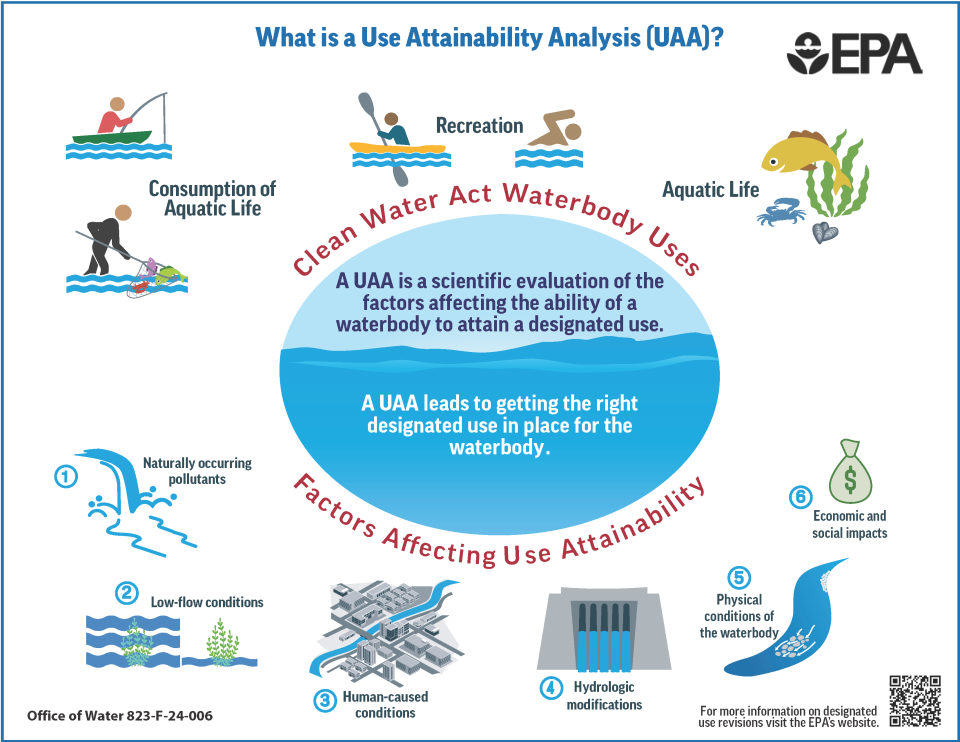Use Attainability Analysis (UAA)
On this page:
- What is a UAA?
- What are the 6 Factors Under 40 CFR 131.10(g)?
- UAA Process Diagram with Tips for Combined Sewer Overflow (CSO) Receiving Waters
- What are some examples of UAAs? (Case Studies)
- What about Potential Economic Impacts?
What is a UAA?
A use attainability analysis (UAA) is a structured scientific assessment of the factors affecting the attainment of uses specified in Section 101(a)(2) of the Clean Water Act. The factors to be considered in such an analysis include the physical, chemical, biological, and economic use removal criteria described in the EPA' s water quality standards (WQS) regulation at 40 CFR 131.10(g)(1)-(6).
A UAA must be conducted for any waterbody when a state or authorized Tribe designates uses that do not include the uses specified in section 101(a)(2) of the Act or when designating sub-categories of these uses that require less stringent criteria than previously applicable. States and authorized tribes must hold public hearings for the purpose of reviewing the applicable WQS at least once every 3 years and when revising water quality standards. States and authorized Tribes must also re-examine waters that do not include the uses specified in section 101(a)(2) of the Act to determine if new information has become available. If new information indicates that the uses specified in CWA section 101(a)(2) are attainable, then the state or authorized Tribe must revise its WQS accordingly to designate such uses.

Diagram: What is a Use Attainability Analysis (UAA)? (pdf)
- Designated Use Revision Infographics
- Improving the Effectiveness of the Use Attainability Analysis Process, Memorandum from Ephraim King (pdf)
What are the 6 Factors Under 40 CFR 131.10(g)?
Under 40 CFR 131.10(g) states may remove a designated use which is not an existing use, as defined in § 131.3, or establish sub-categories of a use if the State can demonstrate that attaining the designated use is not feasible because:
- Naturally occurring pollutant concentrations prevent the attainment of the use; or
- Natural, ephemeral, intermittent or low flow conditions or water levels prevent the attainment of the use, unless these conditions may be compensated for by the discharge of sufficient volume of effluent discharges without violating State water conservation requirements to enable uses to be met; or
- Human caused conditions or sources of pollution prevent the attainment of the use and cannot be remedied or would cause more environmental damage to correct than to leave in place; or
- Dams, diversions or other types of hydrologic modifications preclude the attainment of the use, and it is not feasible to restore the water body to its original condition or to operate such modification in a way that would result in the attainment of the use; or
- Physical conditions related to the natural features of the water body, such as the lack of a proper substrate, cover, flow, depth, pools, riffles, and the like, unrelated to water quality, preclude attainment of aquatic life protection uses; or
- Controls more stringent than those required by sections 301(b) and 306 of the Act would result in substantial and widespread economic and social impact.
UAA Process Diagram with Tips for Combined Sewer Overflow (CSO) Receiving Waters
This interactive diagram is intended to help states, authorized tribes, and territories establish or revise designated uses by addressing the steps and questions they should consider while conducting a UAA. It includes tips for use revisions related to combined sewer overflows (CSOs).
What are some examples of UAAs? (Case Studies)
| Case Study |
Complexity | Type of Action | 131.10(g) Factor(s) |
|---|---|---|---|
|
very simple | Assign primary contact recreational use | n/a |
|
very simple | Redefined as ephemeral stream | 2 |
|
very simple | Aquatic life use support | 2 |
|
simple | Temporary suspension of recreational use | 2, 4 |
|
simple | Assign limited warmwater fishery use | 3, 5 |
|
medium | Assign aquatic life & recreational uses | 3 |
|
medium | Removal of aquatic life uses & development of site-specific criterion | 1, 3 |
|
complex | Temporary standards for multiple uses during remediation | 3 |
|
very complex | Refined aquatic life uses & restoration variance | 1, 3, 6 |
Download all of the case studies. This file includes 2005 Case Studies of Alternatives to Use Removal. Please note that the purpose of this document is to provide examples of UAAs that states have conducted. States may conduct UAAs and then choose not to finalize the use change. For example, MD never adopted a final use change for the Patapsco River following the UAA described on pg. 38 of the document.
What about Potential Economic Impacts?
Refer to the EPA’s Economic Guidance for WQS for assistance in assessing the degree of economic and social impact of potential WQS decisions.
